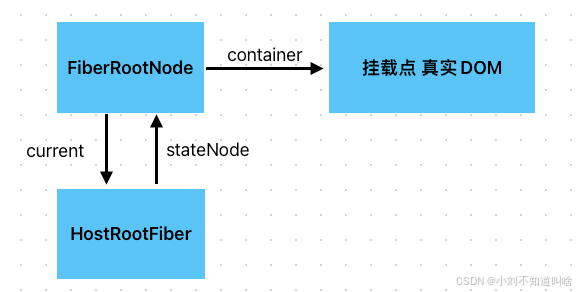本文主要介绍React18版本的初始化启动过程,包含ReactElement元素的创建,createRoot如何创建根节点,以及Fiber树的基本结构,算是揭秘React核心原理的前置知识总结。
本系列文章都基于此项目: GitHub - Gravity2333/My-React at learn
启动模式
在稳定版react@17.0.2后,React包含三种启动模式:
-
Legacy模式,也就是我们熟悉的使用ReactDOM.render(<App/>,container)来渲染组件,这种方式可能不支持最新的Concurrent并发渲染模式。
-
blocking模式,使用ReactDOM.createBlockingRoot(container).render(<App/>) 算是Legacy和Concurrent模式的中间模式,支持小部分并发功能,使用的比较少。
-
Concurrent并发模式,使用ReactDOM.createRoot(container).render(<App/>)开启并发渲染,这个模式开启了完整的并发渲染特性,我们的源码实现也给予这个模式。
React渲染基本原理
简单说一下React的渲染原理,传统命令式的渲染方式需要在数据变动时手动通过浏览器提供的DOM接口(如 documentElem.InnerText等)修改UI,无法做到数据UI同步,React的作用就是在数据变动时通过重新渲染的方式修改UI。
React在真实DOM和数据直接,加入了一层虚拟DOM层,在新版React架构中成为FIber,即纤维的意思,代表可最小范围的更新。
我们知道,对于真实DOM的操作是慢且低效的,而虚拟DOM的优势在于,其是存在内存中的对象。每次更新实际变动的是虚拟DOM对象,不是直接操作真实DOM。
在每次更新之后,React会通过Diff算法(也就是React Reconciler协调机制)对比新旧虚拟DOM对象的不同,仅对变动部分进行更新,以达到最小范围更新,提升更新效率。
ReactElement元素的创建 - createElement
在使用React过程中,我们通常使用JSX语法来编写React组件,JSX会通过babel转换成createElement函数。可以把JSX理解成createElement的语法糖,其优势在于来类HTML标签的写法,很直观,容易理解。

你可以在babel的官网自己尝试一下:Babel · The compiler for next generation JavaScript
createElement函数用于创建ReactElement元素,我们刚说了,React在数据和真实DOM之间建立了一层虚拟DOM,也就是FIber。这里面的数据,就可以理解为ReactElement对象。
我们使用JSX语法编写 函数/类 组件时,本质上就是在调用createElement函数,React会在初次渲染及每次更新的时候重新调用函数或者类组件的render方法,从而获取最新的ReactElement对象,并且通过此创建出中间层Fiber对象,最后通过Diff对比增量修改真实DOM,即如下关系

createElement的调用参数如下:
createElement(type,props,children)
其中,type可能为字符串,函数/类,Memo,Suspense,Context等对象
如: createElement("div",{},[]) 创建一个div元素
createElement(App,{},[]) 创建App函数组件
props为属性,如style ref 等等,需要以对象的方式传入,对于style样式,属性的key需要以驼峰的方式传入 如: style: { backgroundColor: 'red' }
children为子ReactElement元素,需要是一个数组,其中可以传入ReactElement元素,也可以传入字符串/数字作为纯文本节点,或者是一个包含ReactElement元素的数组。
createElement定义在lib/react下,其实现也很简单,就是对传入的参数进行简单的封装,如下:
TypeScript
export type ReactElementType = any;
/** 属性类型 */
export type ReactElementProps = Record<string, any>;
/** key */
export type Key = string;
/** Ref */
export type Ref = { current: any } | ((current: any) => void);
/** children */
export type ReactElementChildren =
| ReactElement
| string
| Array<ReactElementChildren>;
/** Element元素类型 */
export interface ReactElement {
$$typeof: Symbol | number;
key: Key;
ref?: Ref;
type: ReactElementType;
props: ReactElementProps;
}
/** 实现createElement方法 */
export function createElement(
type: ReactElementType,
props: ReactElementProps,
...children: ReactElementChildren[]
): ReactElement {
return {
$$typeof: REACT_ELEMENT_TYPE,
type,
ref: props.ref ? props.ref : null,
key: props.key ? String(props.key) : null,
props: {
...props,
/** 源码这里做了处理 如果只有一个child 直接放到children 如果有多个 则children为一个数组 */
children:
children?.length === 1
? handleChildren(children[0])
: children.map(handleChildren),
},
};
}这里需要注意:
1.如果传入的children只有一个,ReactElement保存时会直接存储这个children的ReactElement对象
- 如果是多个children则存储一个ReactElement数组。
Fiber节点&Fiber树
为什么叫Fiber,Fiber即纤维的含义。当我们使用React渲染DOM结构时,虽然会通过虚拟DOM进行DIFF比较来做到增量修改,但是当DOM的结构复杂规模变大时,仍然会让对比更新的过程耗费很多时间。
传统的虚拟DOM创建和真实DOM更新是同步的,因为React采用了深度优先遍历的方式递归创建虚拟DOM树,其过程无法被打断,导致一次大的更新必须一次性完成,在其计算期间JS引擎占用主线程,导致渲染引擎无法介入,用户事件也无法处理,造成页面卡顿。
Fiber节点的引入就是为了解决递归遍历无法被"打断"的问题,新版本的React将递归优化成非递归的形式,使用workInProgress全局变量来记录当前深度优先遍历处理到的节点,DIFF的单位也从整颗虚拟DOM树变成了单个Fiber节点。
在遍历的过程中,如果有更高优先级的任务到达(如用户事件)或者需要渲染引擎介入(到达16.7ms 一帧结束)React会暂停FIber树的构建,让出主线程,当主线程空闲时继续处理,这样就保证了用户事件及时响应以及页面的流畅!
同时,Fiber节点作为ReactElement和真实DOM的中间层,需要记录节点之间的关联信息,以及组件本身的状态信息,当我们使用hooks记录管理状态时,其本质就是在Fiber节点上进行存储。
Fiber节点由FiberNode类创建,其定义如下:
TypeScript
/** Fiber节点类 */
export class FiberNode {
// 唯一id
key: Key;
// fiber节点的类型
tag: WorkTag;
/** element对应的Type */
type: ReactElementType;
/** ref */
ref: Ref;
// 对应的dom节点 可能为null
stateNode: any;
// 记录状态信息
memorizedState: any;
// 记录的Props
memorizedProps: ReactElementProps;
// 表示fiber node之间的关系
index: number; // diff比较的index
sibling: FiberNode | null; // 兄弟节点
return: FiberNode | null; //父节点
child: FiberNode | null; // 子节点
// flags 副作用
flags: Flags; // 当前节点的flag
subTreeFlags: Flags; // 当前节点为根的子树flag的merge
pendingProps: ReactElementProps; // 待处理的props
delections: FiberNode[];
// 更新队列
updateQueue: UpdateQueue<any> | null;
// 双缓存
alternate: FiberNode | null;
/** lane相关 */
/** 当前fiber上的更新lanes */
lanes: Lanes;
/** 当前fiber的子fiber树上的优先级 */
childLanes: Lanes;
constructor(tag: WorkTag, pendingProps: ReactElementProps, key: Key) {
// 没传key的情况下 都是null 在Diff reconcileArray的时候 会使用index
this.key = key || null;
this.tag = tag;
this.type = null;
this.ref = null;
this.stateNode = null;
this.memorizedState = null;
this.memorizedProps = null;
this.index = 0;
this.sibling = null;
this.child = null;
this.return = null;
// 副作用
this.flags = NoFlags;
this.subTreeFlags = NoFlags;
this.pendingProps = pendingProps;
this.delections = null;
this.updateQueue = null;
this.alternate = null;
/** lanes相关 */
this.lanes = NoLanes;
this.childLanes = NoLanes;
}
}Fiber节点的关系
React每次更新,都会生成一棵Fiber节点构成的Fiber树,其内部结构采用了 孩子兄弟表示法 ,对于上面的例子,其结构如下:
 每个Fiber节点包含以下几个指针:
每个Fiber节点包含以下几个指针:
- child指针,指向第一个孩子节点,如ul的child指向第一个li节点
- sibling指针,指向兄弟节点,如第一个li的sibling指向第二个li
- return指针,指向父节点,三个li的return都指向ul
使用这种数据结构存储Fiber节点的好处是,方便深度优先遍历整颗Fiber树,即从根节点的Fiber一只顺着.child向下找,找到child为null时回溯,如果回溯到的节点有sibling兄弟,则继续向下找,来模仿递归的过程。如下图
整个应用的根 - FiberRootNode
FiberRootNode和HostRootFiber是两个容易混淆的概念,前者为整个应用的根,在一个React应用中有且仅有一个,后者是Fiber树的根,由于React采用双缓冲树,HostRootFiber可能有两个。
Host即宿主的意思,我们一般称Fiber树的根节点为HostRoot 普通节点如 div span a等宿主浏览器提供的节点类型为HostComponent 文本节点为HostText。
FiberRootNode是整个应用的根,保存着一些全局的信息,其实现如下:
TypeScript
/** 只有一个 整个应用的根 */
export class FiberRootNode {
current: FiberNode;
container: Container;
finishedWork: FiberNode | null;
/** 表示commit阶段收集到的 等待被处理的被动Effect 被动Effect: 不会引起重新渲染的effect*/
pendingPassiveEffects: PendingPassiveEffect;
/** 和lane相关的属性 */
/** 当前还未运行的任务的lane合集 */
pendingLanes: Lanes;
/** 已经完成运行的更新对应的lane 在render阶段结束之后设置,在commit阶段置空 类似于finishedWork */
finishedLane: Lane;
/** 需要传入container 和 第一个HostRootFiber */
constructor(conatiner: Container, hostRootFiber: FiberNode) {
/** 保存container */
this.container = conatiner;
this.finishedWork = null;
/** 需要建立关系:
* FiberRootNode.current -> hostRootFiber
* hostRootFiber.stateNode -> FiberRootNode
*/
this.current = hostRootFiber;
hostRootFiber.stateNode = this;
/** 初始化pendingPassiveEffect */
this.pendingPassiveEffects = {
unmount: [],
update: [],
};
/** 初始化lane */
this.pendingLanes = NoLanes;
this.finishedLane = NoLane;
}
}需要关注其中几个比较重要的属性。
我们知道,React在工作初始化时,需要绑定一个挂载点,通常是一个真实DOM元素,在早起的legacy模式中,我们使用ReactDOM.render(<App/>,Container)来把Container容器绑定到React上。新版本中,我们通过ReactDOM.createRoot(Conatiner)创建根(也就是FiberRootNode节点)并且传入Container,这个Container就保存在FiberRootNode的container属性上。
同时,我们还需要传入初始化的Fiber树根,即HostRootFiber,其和FiberRootNode的关系如下:

其中,HostRootFiber的stateNode节点指向FiberRootNode
FiberRootNode的current节点指向HostRootFiber
这样双向的指向方便互相查找。完善后的完整Fiber树结构如图所示:
根的创建
根的创建是由定义在ReactDOM中的createRoot函数完成,其实现如下:
TypeScript
/** 创建应用根节点FiberRootNode 以及第一个HostRoot节点 hostRootFiber */
const createContainer = (container: Container) => {
// 第一个hostRoot节点
const hostRootFiber = new FiberNode(HostRoot, {}, null);
// 创建整个应用的根节点: FiberRootNode
const root = new FiberRootNode(container, hostRootFiber);
// 创建一个hostRootFiber的更新队列 (updateQueue) 存放的是新的root element
hostRootFiber.updateQueue = new UpdateQueue<ReactElement>();
return root;
};
/**
* 更新container 需要传入
* @param element 新的element节点
* @param root APP根节点
*/
const updateContainer = (element: ReactElement, root: FiberRootNode) => {
// 默认情况下 同步渲染
scheduler.runWithPriority(PriorityLevel.IMMEDIATE_PRIORITY, () => {
// 请求获得当前更新lane
const lane = requestUpdateLane();
// 获hostRootFiber
const hostRootFiber = root.current;
// 更新的Element元素入队
hostRootFiber.updateQueue?.enqueue(
new Update<ReactElement>(element, lane),
hostRootFiber,
lane
);
// scheduleUpdateOnFiber 调度更新
scheduleUpdateOnFiber(root.current, lane);
});
};
/** 创建根节点的入口 */
export function createRoot(container: Container) {
// 创建FiberRootNode
const root = createContainer(container);
return {
render(element: ReactElement) {
// TODO
// 初始化合成事件
initEvent(container);
// 更新contianer
return updateContainer(element, root);
},
};
}其中 createContainer函数根据createRoot传入的container容器节点,创建出FiberRootNode以及HostRootFiber 并且完成二者的关联以及container与FiberRootNode的绑定,并且返回根节点。
createRoot返回一个包含render方法的对象,调用者调用render函数并且传入要渲染的ReactElement对象,开启渲染流程。即如下调用
TypeScript
// index.ts
import { createElement } from "../lib/react";
import { createRoot } from "../lib/react-dom";
import App from "./App";
const root = createRoot(document.querySelector("#root-master"));
root.render(createElement(App, {}));以上为React开启渲染流程的入口和前置知识。

